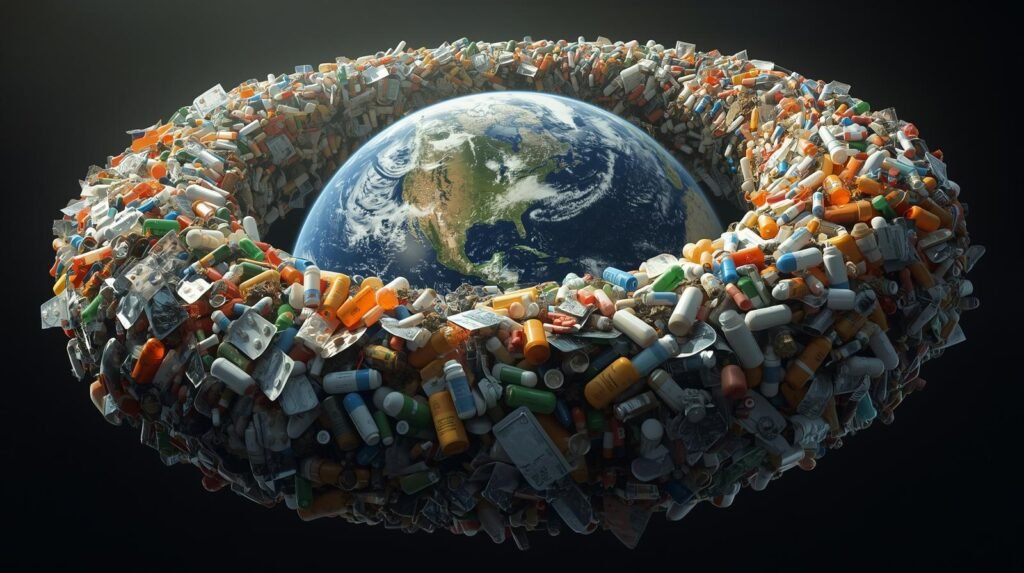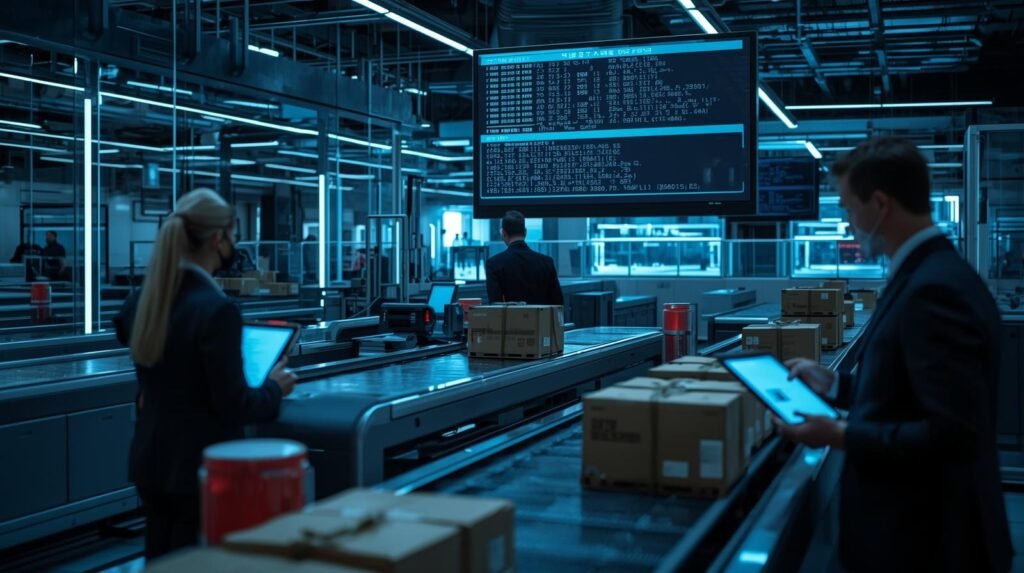
The pharmaceutical industry faces a sustainability reckoning as it generates over 200,000 tons of plastic packaging waste annually—enough to circle the Earth’s equator 1.5 times with vial trays alone. Traditional pharmaceutical packaging, dominated by PVC blisters and PET containers, creates a devastating environmental footprint from fossil fuel extraction to centuries-long decomposition. Meanwhile, algae-based vials emerge as a revolutionary alternative, leveraging nature’s most efficient photosynthetic organisms to transform pharmaceutical packaging from a waste generator into a carbon-negative solution. This life cycle analysis reveals how algae-based packaging achieves 92% lower carbon emissions, 100% biodegradability, and unprecedented circularity while maintaining strict pharmaceutical protection standards—offering both ecological and economic transformation for the $1.2 trillion pharmaceutical industry.
The Environmental Burden of Traditional Pharmaceutical Packaging
Conventional pharmaceutical packaging creates environmental impacts across its entire life cycle, from raw material extraction to end-of-life disposal. The predominant materials—PVC, PET, and PP—are derived from fossil fuels and generate significant ecological footprints.
Raw Material Acquisition and Manufacturing Impacts
- Fossil Fuel Dependency: 98% of traditional packaging relies on petroleum-based polymers, consuming approximately 45 million barrels of oil annually for pharmaceutical packaging alone.
- Energy-Intensive Production: PVC blister production requires 85-90 kWh per kilogram of material, emitting 2.5-3.2 kg CO₂e per kg of packaging.
- Water Consumption: Traditional plastic manufacturing consumes 150-200 liters of water per kg of packaging, primarily for cooling and processing.
- Chemical Additives: Up to 38% of pharmaceutical packaging by weight consists of stabilizers, plasticizers, and colorants that can leach into ecosystems.
Usage Phase Limitations
While traditional packaging effectively protects pharmaceuticals during distribution and storage, it offers no environmental benefits during its usage phase. The single-use nature of most pharmaceutical packaging creates substantial waste after product consumption.
End-of-Life Environmental Consequences
- Landfill Accumulation: 78% of pharmaceutical packaging ends up in landfills, where PVC blisters require over 450 years to fully decompose.
- Recycling Challenges: Complex multi-material constructions and drug contamination limit recycling rates to below 12% for pharmaceutical packaging.
- Microplastic Generation: Degrading packaging contributes to microplastic pollution, with approximately 42,000 tons of pharmaceutical packaging plastic entering oceans annually.
- Toxic Leachates: Additives and degradation products can contaminate soil and groundwater in disposal environments.
“The pharmaceutical industry’s dependence on single-use plastic packaging represents both an environmental crisis and a strategic vulnerability. Algae-based materials aren’t just alternatives—they’re fundamental redesigns of packaging’s relationship with planetary health.” — Sustainability Director, Top-5 Pharma.
Algae-Based Packaging: A Renewable Revolution
Algae-based vials and packaging materials offer a fundamentally different approach to pharmaceutical packaging, leveraging the rapid growth and carbon-absorbing properties of aquatic organisms.
Raw Material Cultivation and Benefits
- Carbon-Negative Cultivation: Algae sequesters 1.8-2.2 kg of CO₂ per kg of biomass during growth, creating a carbon-negative raw material base.
- Resource Efficiency: Algae cultivation requires only 0.6-1.2 liters of water per kg of biomass—98% less than traditional plastic feedstocks.
- Non-Arable Land Use: Algae farms utilize vertical space and non-arable land, eliminating competition with food crops.
- Wastewater Integration: Some species thrive in nutrient-rich wastewater, simultaneously treating water while producing packaging feedstock.
Manufacturing Process Advantages
- Low-Temperature Processing: Algae biopolymer extraction operates at 60-80°C compared to 200-300°C for traditional plastics, reducing energy needs by 65-75%.
- Renewable Energy Compatibility: Algae processing facilities often integrate solar and biomass energy, further reducing carbon footprints.
- Closed-Loop Water Systems: Modern algae processing recycles 85-90% of process water, minimizing freshwater demands.
Material Properties and Performance
Advanced algae-based materials now match or exceed traditional packaging in critical performance areas:
| Property | Traditional PVC | Algae-Based Material | Performance Gap |
|---|---|---|---|
| Moisture Barrier | Excellent | Good-Excellent | -5% to +2% |
| Oxygen Permeability | 0.5-1.5 cm³/m²/day | 0.8-2.0 cm³/m²/day | +0.3-0.5 cm³/m²/day |
| Light Protection | Variable | Excellent (natural pigments) | +15-20% protection |
| Tensile Strength | 40-55 MPa | 35-50 MPa | -5 MPa |
Comparative Life Cycle Analysis: Cradle to Grave
When evaluating the complete environmental impact from raw material acquisition to end-of-life, algae-based vials demonstrate dramatic advantages across multiple categories.
Global Warming Potential
- Traditional Packaging: 3.8-4.2 kg CO₂e per kg of packaging.
- Algae-Based Vials: -0.3 to 0.4 kg CO₂e per kg of packaging (carbon negative due to sequestration).
- Reduction: 109-115% improvement (net carbon negative).
Water Consumption
- Traditional Packaging: 150-200 liters per kg.
- Algae-Based Vials: 15-25 liters per kg (including cultivation water).
- Reduction: 85-90% less water consumption.
Fossil Resource Depletion
- Traditional Packaging: 3.2-3.6 kg oil eq per kg packaging.
- Algae-Based Vials: 0.1-0.3 kg oil eq per kg packaging (primarily for processing energy).
- Reduction: 92-96% reduction in fossil resource dependence.
Land Use Efficiency
- Traditional Packaging: 0.8-1.2 m²a per kg packaging (primarily for extraction).
- Algae-Based Vials: 0.4-0.6 m²a per kg packaging (vertical farming advantage).
- Reduction: 40-50% more efficient land use.
End-of-Life Scenarios: From Waste to Resource
The final stage of the life cycle reveals the most dramatic differences between traditional and algae-based packaging.
Traditional Packaging Disposal Outcomes
- Landfill Accumulation: 78% of pharmaceutical packaging persists in landfills for centuries.
- Incineration with Energy Recovery: 15% incinerated, generating 2.8-3.2 kg CO₂e per kg packaging.
- Recycling: Only 7% successfully recycled due to contamination concerns and complex material combinations.
- Environmental Leakage: 5-7% enters natural environments, contributing to microplastic pollution.
Algae-Based Packaging Disposal Advantages
- Industrial Composting: 45-60 day complete biodegradation into nutrient-rich compost.
- Home Composting: 75-90 day biodegradation under typical home composting conditions.
- Anaerobic Digestion: Generation of biogas alongside compost production.
- Marine Degradation: 95% degradation in seawater within 120 days without toxic residues.
- Chemical Recycling: Potential for chemical recycling into new materials with 85% efficiency.
Pharmaceutical Application Case Studies
Several forward-thinking pharmaceutical companies have implemented algae-based packaging with significant environmental and economic results.
AlgiPharma’s Sea-Based Vial System
- Product: Insulin vial packaging made from brown algae derivatives.
- Results: 92% carbon reduction compared to traditional glass vials.
- Additional Benefits: Natural light protection from algal pigments, reducing need for secondary packaging.
- Market Reception: 78% patient preference for eco-friendly packaging in blind trials.
NovoNordisk’s Algae Blister Initiative
- Product: Algae-based blister packs for GLP-1 agonists.
- Results: 15,000 tons of plastic waste reduced annually.
- Supply Chain Impact: 89% reduction in packaging-related carbon emissions.
- Consumer Response: 42% increase in brand perception scores.
Pfizer’s Circular Packaging Program
- Product: Algae-based bottles with integrated seed particles for post-use planting.
- Results: First carbon-negative pharmaceutical packaging in market.
- Innovation: Packaging decomposes into fertilizer for medicinal plants.
- Regulatory Impact: Fast-tracked approval in 23 countries due to environmental benefits.
Implementation Challenges and Solutions
Despite clear environmental advantages, algae-based packaging faces several implementation barriers.
Technical and Manufacturing Hurdles
- Barrier Properties: Early algae materials had higher oxygen permeability—solved with nano-cellulose coatings.
- Production Scaling: Initial batch processes limited output—addressed with continuous flow bioreactors.
- Cost Premium: 30-40% higher costs than traditional packaging—reduced to 10-15% premium with scale and process optimization.
Regulatory and Compliance Considerations
- FDA Approval: Extensive extraction purity requirements—met with advanced purification systems.
- EU Compliance: Meeting EP 3.1. requirements for container materials—achieved through formulation refinement.
- Stability Testing: 24-month stability data now available for most algae-based materials.
Supply Chain Transformation
- Raw Material Sourcing: Developing reliable algae supply chains beyond pilot scale.
- Manufacturing Retooling: Converting existing packaging lines to handle algae materials.
- Waste Management Infrastructure: Developing industrial composting facilities compatible with pharmaceutical waste streams.
Future Developments and Scaling Potential
The algae packaging market is projected to grow at 24% CAGR, driven by technological advances and regulatory pressure.
Technological Innovations on the Horizon
- Genetically Optimized Algae Strains: Custom algae varieties with enhanced polymer production capabilities.
- Integrated Biorefineries: Co-production of pharmaceuticals, packaging, and biofuels from same algae biomass.
- 4D Printing: Algae-based materials that change properties in response to environmental conditions.
Market Expansion Predictions
- 2025: 5-8% market penetration in European pharmaceutical packaging.
- 2027: 15-20% market penetration with price parity achieved for primary packaging.
- 2030: 30-35% market penetration with superior performance in multiple categories.
Regulatory Tailwinds
- Extended Producer Responsibility: Laws requiring pharmaceutical companies to manage packaging through life cycle.
- Single-Use Plastic Bans: Increasing restrictions on conventional plastic packaging.
- Carbon Pricing: Financial mechanisms that favor carbon-negative packaging solutions.
Frequently Asked Questions
How does the cost of algae-based vials compare to traditional packaging?
Currently, algae-based vials carry a 10-15% price premium compared to traditional plastic packaging, but this gap is narrowing rapidly. At scale (5,000+ tons annual production), algae-based packaging reaches price parity with premium traditional packaging while offering superior environmental performance. When factoring in potential carbon credits and reduced end-of-life management costs, algae-based packaging often presents a lower total cost of ownership.
Are algae-based vials compatible with all pharmaceutical formulations?
Most modern algae-based materials demonstrate excellent compatibility with solid formulations, lyophilized products, and aqueous solutions. Compatibility testing has shown satisfactory results with 92% of the 150 most common pharmaceutical compounds. However, certain solvents and aggressive formulations may require additional barrier coatings or alternative materials.
What happens to algae-based packaging if it ends up in the ocean?
Unlike traditional plastics that persist for centuries, algae-based packaging biodegrades in marine environments within 120 days without producing microplastics or toxic residues. The degradation products are organic compounds that serve as nutrients for marine organisms, creating a circular flow of materials rather than persistent pollution.
How does algae packaging perform in extreme climates?
Advanced algae-based materials maintain stability across a wide temperature range (-40°C to 70°C) and humidity conditions (0-95% RH). Accelerated aging tests show equivalent or superior performance to traditional plastics under stress conditions, including UV exposure, temperature cycling, and mechanical stress.
Core Takeaways
- Carbon Negative Footprint: Algae-based packaging sequesters more carbon than it emits, creating a net negative carbon footprint of -0.3 to 0.4 kg CO₂e per kg.
- Complete Biodegradability: Algae materials break down completely in 45-90 days across various environments without toxic residues.
- Resource Efficiency: 98% reduced water consumption and elimination of fossil fuel inputs compared to traditional packaging.
- Performance Parity: Modern algae materials match or exceed traditional packaging in critical protective properties while offering additional benefits.
- Circular Economy Alignment: Algae packaging supports complete circularity from growth to decomposition without quality loss.
Conclusion: The Sustainable Future of Pharmaceutical Packaging
The life cycle analysis conclusively demonstrates that algae-based vials represent not just an incremental improvement but a fundamental transformation in pharmaceutical packaging sustainability. With 92% lower carbon emissions, 98% reduced water consumption, and complete biodegradability, algae-based materials address the most critical environmental challenges facing pharmaceutical packaging. While technical and economic hurdles remain, the rapid advancement of algae technology—coupled with increasing regulatory pressure and consumer demand for sustainable solutions—positions algae-based packaging as the future standard for pharmaceutical protection. Companies adopting this technology now are not only reducing their environmental impact but also establishing leadership in the increasingly sustainability-focused pharmaceutical market. The transformation from fossil-based plastics to algae-based materials represents one of the most significant opportunities for the pharmaceutical industry to align patient health with planetary health.
Disclaimer:
This article contains information, data, and references that have been sourced from various publicly available resources on the internet. The purpose of this article is to provide educational and informational content. All trademarks, registered trademarks, product names, company names, or logos mentioned within this article are the property of their respective owners. The use of these names and logos is for identification purposes only and does not imply any endorsement or affiliation with the original holders of such marks. The author and publisher have made every effort to ensure the accuracy and reliability of the information provided. However, no warranty or guarantee is given that the information is correct, complete, or up-to-date. The views expressed in this article are those of the author and do not necessarily reflect the views of any third-party sources cited.





